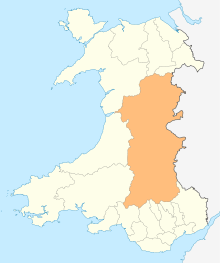Caersws railway station
Caersws railway station is a railway station on the Cambrian Line in mid-Wales, serving the village of Caersws. It is notable that there is a distance of 22 miles (35 km) between this station and Machynlleth, the longest distance between two intermediate stations in Wales.[2]
| Caersws | |
|---|---|
| Welsh: Caersŵs | |
.jpg) | |
| Location | |
| Place | Caersws |
| Local authority | Powys |
| Coordinates | 52.516°N 3.433°W |
| Grid reference | SO028918 |
| Operations | |
| Station code | CWS |
| Managed by | Transport for Wales |
| Number of platforms | 1 |
| DfT category | F1 |
| Live arrivals/departures, station information and onward connections from National Rail Enquiries | |
| Annual rail passenger usage* | |
| 2014/15 | |
| 2015/16 | |
| 2016/17 | |
| 2017/18 | |
| 2018/19 | |
| History | |
| Key dates | Opened 3 January 1863[1] |
| Original company | Newtown and Machynlleth Railway |
| Pre-grouping | Cambrian Railways |
| National Rail – UK railway stations | |
| * Annual estimated passenger usage based on sales of tickets in stated financial year(s) which end or originate at Caersws from Office of Rail and Road statistics. Methodology may vary year on year. | |
History
The notable Welsh romantic poet John Ceiriog Hughes was employed as a station master and Manager of the Van Railway at Caersws railway station from 1868 until his death in 1887.[3]
From 1871 to 1940 the Van Railway terminated at Caersws. The station was built by the Newtown and Machynlleth Railway of the Cambrian Railways in the 1890s. Originally there was a passing loop, a goods shed, a water tower and a ticket office and a signal box - the latter remained in use until March 2011 as a gate box to supervise the station level crossing (this is now operated from Machynlleth).
The station was threatened with closure in 1964 along with all of the other wayside stops on the former Cambrian main line (as a consequence of the Beeching Axe), but reprieved by the then Minister of Transport Tom Fraser in December that year to act as the notional railhead for the town of Llanidloes (following the demise of the Mid-Wales Railway that served it directly).[4]
In February 2013, Caersws station won the "Wales’ Best Unstaffed Train Station" award, supported by Keep Wales Tidy.[5]
Facilities
Though unstaffed, the station has a ticket machine installed. Train running information is offered via CIS displays, automated announcements, timetable poster boards and a customer help point (as is usual for ATW-managed stations). There is also payphone available.[6] Step-free access is available from the entrance to the platform.
Services
There is a basic two-hourly service in each direction Mon-Sat, with some additional services in the morning and evening (most of which run between Shrewsbury and Aberystwyth only). Sundays also run every two hours, though there is only a limited service (one in winter, three in summer) along the Cambrian Coast line to Pwllheli.[7][8]
| Preceding station | Following station | |||
|---|---|---|---|---|
Newtown | Transport for Wales Cambrian Line | |||
| Disused railways | ||||
| Pontdolgoch Line open, station closed |
Great Western Railway Newtown and Machynlleth Railway |
Moat Lane Junction Line open, station closed | ||
| Trewythan Line and station closed |
Van Railway | Terminus | ||
Gallery
 Bilingual sign at Caersws station in the early 2000s
Bilingual sign at Caersws station in the early 2000s Caersws station in the early 2000s
Caersws station in the early 2000s Caersws station in September 2009
Caersws station in September 2009.jpg) Ticket machine and station building (2015)
Ticket machine and station building (2015).jpg) Caersws station and signal box (2015)
Caersws station and signal box (2015)
References
- Butt 1995, p. 51.
- "Support to re-open Carno railway station". BBC NEWS. 6 January 2016.
- C P Gasquoine (1973). The Story of the Cambrian. Christopher Davies Ltd.
- Disused Stations - Montgomery Disused Stations Site Record; Retrieved 31 July 2017
- http://www.keepwalestidy.org/10408%5B%5D
- Caersws station facilities National Rail Enquiries
- Arriva Trains Wales Timetables Archived 29 January 2015 at the Wayback Machine Retrieved 6 May 2016
- Table 76 National Rail timetable, May 2017
Sources
- Butt, R. V. J. (1995). The Directory of Railway Stations: details every public and private passenger station, halt, platform and stopping place, past and present (1st ed.). Sparkford: Patrick Stephens Ltd. ISBN 978-1-85260-508-7. OCLC 60251199.
External links
![]()
- Train times and station information for Caersws railway station from National Rail
